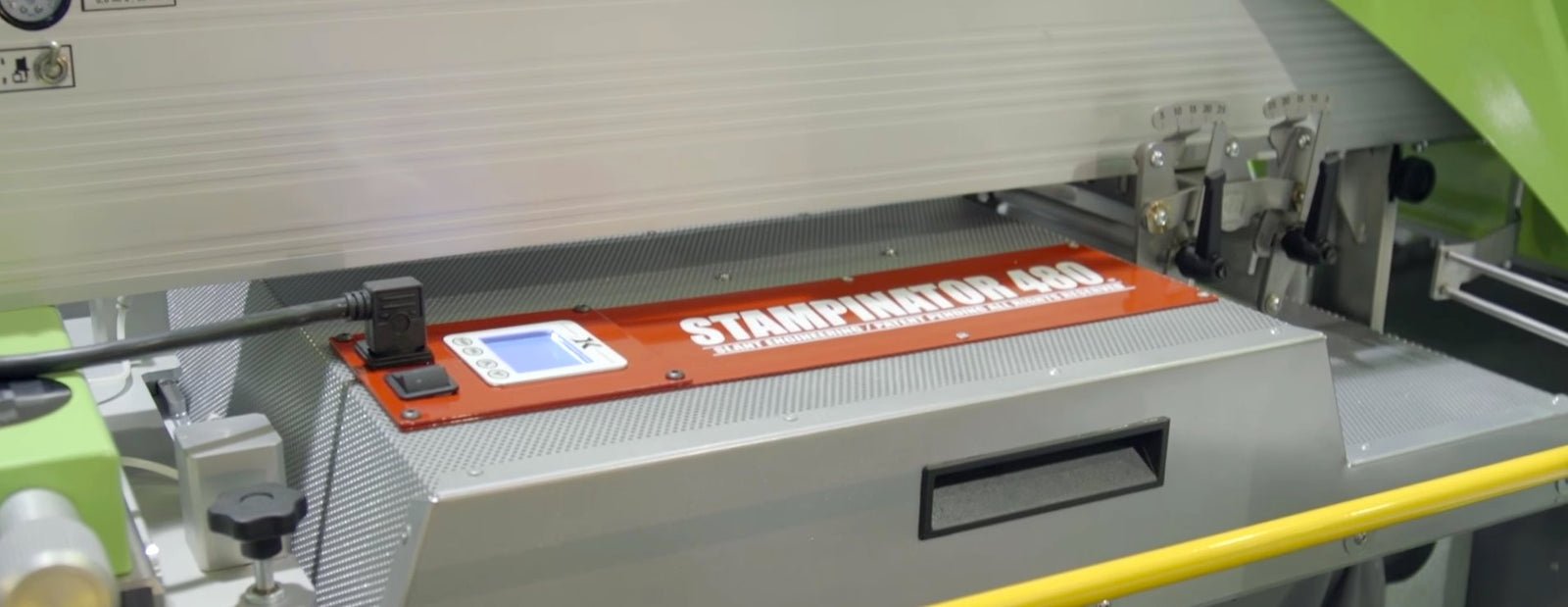Learn how the latest innovation in the industry can more than halve the time you spend doing team uniforms or heat sealing transfers.
There now is a piece of equipment that will revolutionize the decoration of team uniforms as well as dramatically speed up heat applied graphics printing.
Introducing: The Stampinator
Printing team uniforms is one of the industry’s biggest markets. But having to put an individual player’s number and name on a single piece is a time-consuming, laborious task no matter how you do it.
It’s easy to print the team or mascot name on all the shirts, but adding the number requires using a screen print number stencil, a screen printing numbering machine or to take the shirt off the press and apply heat transfer or vinyl numbers using a heat press. It’s always been a two-step process.
“Let’s say, you have a 288-piece order,” says Jeff Fiorucci, inventor and president, Slant Engineering, Baltimore. “After you’re done with the printing, you need another six hours just to apply the heat seal numbers.”
“I wanted to find a way to work smarter and be more efficient, and that’s how I came up with the concept for The Stampinator. It allows us to eliminate that second step,” he says.
The result is a press attachment that functions as an inline heat seal press. Weighing only 75 pounds, it is held in place by the front or rear frame clamps. The temperature can be set anywhere between 32 degrees F and 600 degrees F. When used on an automatic press, the dwell time is determined by settings on the print head. The pressure is determined by the off contact of the print head. When the mechanism comes down, it cures the ink and seals the transfer all at once. The job is done, and the shirt never has to leave the press.
What Fiorucci has learned — having used the invention in his own shop for the past three years, printing more than 80,000 units — is for most plastisol inks, with the temperature set between 320 and 325 degrees F, the print will fully cure in seven seconds.
It doesn’t take much imagination to realize how much faster this makes the production of sports uniforms. Let’s consider the sequence of printing a typical order, which is a two-color team name with a number.
“The first step is to lay down your transfer number using a spray adhesive. We use an embroidery spray adhesive, because it contains a low amount of starch. This keeps it in place while the shirt is being screen printed.”
“If you’re printing on a dark color, you’ll print the white underbase and flash. Then you print the next two colors wet on wet. The next station is The Stampinator. It comes down for seven seconds at 320 degrees and cures the ink and heat seals the number all at the same time. The shirt is pulled off and it’s ready to be packed,” says Fioruuci.
But that is only one application that the Stampinator can be used for. Imagine a short-run order of between 12 and 72 shirts. It doesn’t matter how many colors, once the final color is printed, it goes under the heat seal unit and cures in seven seconds at around 320 degrees. The step of pulling it off the platen and placing it on a conveyor dryer is eliminated.
Imagine having a job, as Fiorucci once did, to adhere 5,000 transfers to a performance wear garment. Before The Stampinator, it took his shop approximately two weeks using traditional heat presses to complete this job.
Now, Fiorucci loads shirts on his 6 color 8 station automatic, and pressing a transfer on each shirt for 8 seconds, finishes the same size job in an eight-hour day. He estimates doing heat seal printing only, he can churn out 480 pieces an hour. It becomes, in essence, the world’s most automated heat printing press.
The entrepreneur reports that this added capability has enabled him to significantly increase the promotional products side of his business adding heat seal logos to caps, umbrellas, tote bags, and more.
Fiorucci spent years fine tuning the process in his shop, and any printer adding the Stampinator will also have some experimenting to do.
“Because there are so many different fabrics and inks, individual shop owners will need to do testing on their own equipment to see what works. To be successful with The Stampinator, the user will need to have some knowledge of the proper screens with the right mesh. You do not want ink to build up and cause bleeding.”
“There would be some training necessary for the new shop. But the average screen printer could probably get it set up and running that same day,” he notes.
Testing also will be required whenever a job is combining curing plastisol ink and heat sealing a number or transfer.
“First, you’ve got to look at who your customers are,” says Fiorucci. “What products are you printing on? Whether it’s performance wear, polyester or cotton. Then look at your inks and which ones are going to work with your transfers. You will need to choose an ink and transfer combination with similar curing temperatures.”
For the heat transfer step, it is recommended to use a piece of Kraft paper or a silicone-coated sheet. It also can be used to mat down fibers to reduce fibrillation.
The outer dimensions of The Stampinator are 22 inches wide by 32 inches long by 6 inches deep. It requires 3600 watts/17A/220 volts and can be powered by running an extension cord out to the press. It fits on most automatic presses with front and rear clamps including ROQ, M&R, Workhorse, and MHM.

